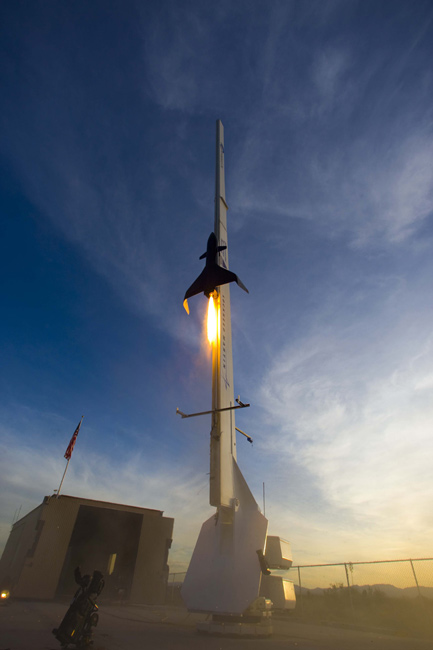Reusable Rocket Plane Soars in Test Flight

A reusable rocket plane has made a successful test flight from New Mexico's Spaceport America — a prototype craft built to showcase proprietary advanced launch technologies.
The small unpiloted vehicle soared into New Mexico skies on Oct. 10, making use of launch services provided by UP Aerospace of Denver, Colo.
"The effort was similar to the activity that we've done in the past," said Slater Voorhees, project lead for Advanced Programs at Lockheed Martin Space Systems Company in Littleton, Colorado.
The most recent test was the third in a series. Previous flights took place in December 2007 and in August 2008 — although the second flight suffered an in-flight anomaly causing loss of the craft.
"This one was a success. It met all of our mission success goals," Voorhees explained.
Hands-on hardware
There is no substitute for flying hardware, Voorhees added. In-flight data was both streamed down to the ground and logged onboard the rocket plane.
"We've analyzed things. We've done studies. We've built tools to model things. But we wanted to take it one step further — to get our engineers using hands-on hardware," Voorhees told SPACE.com. "There's just so much you can do when you simulate things, study things, and do PowerPoint presentations. You do learn a lot."
Get the Space.com Newsletter
Breaking space news, the latest updates on rocket launches, skywatching events and more!
Voorhees said that the purpose of the test flights is to take a look at tackling the ground and launch operations for responsive space needs. That includes advancing leaner, less-costly, and more rapid launch-to-space capabilities.
The craft is a prototype, Voorhees said, a demonstration and data-gathering experiment. "We're trying to understand various technologies of systems and how they play together," he added.
While Voorhees was reticent on providing specific details about the vehicle, earlier accounts of the first two flights pegged the winged hardware at 200-pounds (91 kg). The vehicle is some 8 feet (2.4 meters) long with a wingspan of about 6 feet (1.8 meters). On its first flight, the vehicle flew skyward from an UP Aerospace launch rail to an altitude of roughly 3,001 feet (915 meters).
How the craft is powered has not been revealed.
A quiet event
Working out of Spaceport America and in cooperation with UP Aerospace has proven beneficial, Voorhees noted.
The inland launch complex — that includes UP Aerospace launch facilities — is being built upon 27 square miles in New Mexico, some 30 miles (48 km) east of Truth or Consequences and 45 miles (72 km) north of Las Cruces.
"Working with Spaceport America — it's kind of a green field, a clean slate," Voorhees said. Lockheed Martin has signed a Memorandum of Understanding with the New Mexico Spaceport Authority (NMSA) to conduct testing at Spaceport America.
The recent test flight was a non-public, unpublished event at the request of Lockheed Martin.
"Saturday's launch successfully lifted off at 9:45 a.m. during our four-hour launch window," said Jerry Larson, President of UP Aerospace.
"This is our third launch for Lockheed Martin from Spaceport America, which is proving to be an ideal location for supplying low-cost, fast-turnaround launch operations," Larson said in a press statement issued by the NMSA.
Larson told SPACE.com that the suborbital launch of the rocket plane performed a planned trajectory, landing right on target in a pre-determined touchdown zone at the spaceport.
"Our recovery crew was dispatched within 20 minutes after touchdown and we were able to return the vehicle to our customer for evaluation that same morning," Larson said.
The flight of the test craft followed a very short launch campaign, Larson said. "We spent just a few days setting up and testing and then launched during our first window — our smoothest launch campaign yet."
Runway under construction
According to Larson, his company's launch business is growing.
"This launch marked the third we have done this year — the most launches we've conducted in any year. This test flight also marked our seventh launch from Spaceport America," Larson added. "There is a growing interest in more launches coming from the U.S. Air Force, Lockheed Martin and others for next year that could potentially more than double the number of missions in a year."
Currently under construction, Spaceport America is tagged as "the world's first purpose-built commercial space facility."
Spaceport America is working with a number of companies, such as Virgin Galactic, Lockheed Martin, Moog-FTS, UP Aerospace, and Armadillo Aerospace.
Now being built is Spaceport America's 10,000-foot long runway, initially geared for handling flight operations of Virgin Galactic's WhiteKnightTwo/SpaceShipTwo launch system.
That runway is expected to be complete by late summer 2010 with the Terminal Hangar Facility projected to be complete by early 2011.
Leonard David has been reporting on the space industry for more than four decades. He is past editor-in-chief of the National Space Society's Ad Astra and Space World magazines and has written for SPACE.com since 1999.
Join our Space Forums to keep talking space on the latest missions, night sky and more! And if you have a news tip, correction or comment, let us know at: community@space.com.

Leonard David is an award-winning space journalist who has been reporting on space activities for more than 50 years. Currently writing as Space.com's Space Insider Columnist among his other projects, Leonard has authored numerous books on space exploration, Mars missions and more, with his latest being "Moon Rush: The New Space Race" published in 2019 by National Geographic. He also wrote "Mars: Our Future on the Red Planet" released in 2016 by National Geographic. Leonard has served as a correspondent for SpaceNews, Scientific American and Aerospace America for the AIAA. He has received many awards, including the first Ordway Award for Sustained Excellence in Spaceflight History in 2015 at the AAS Wernher von Braun Memorial Symposium. You can find out Leonard's latest project at his website and on Twitter.









